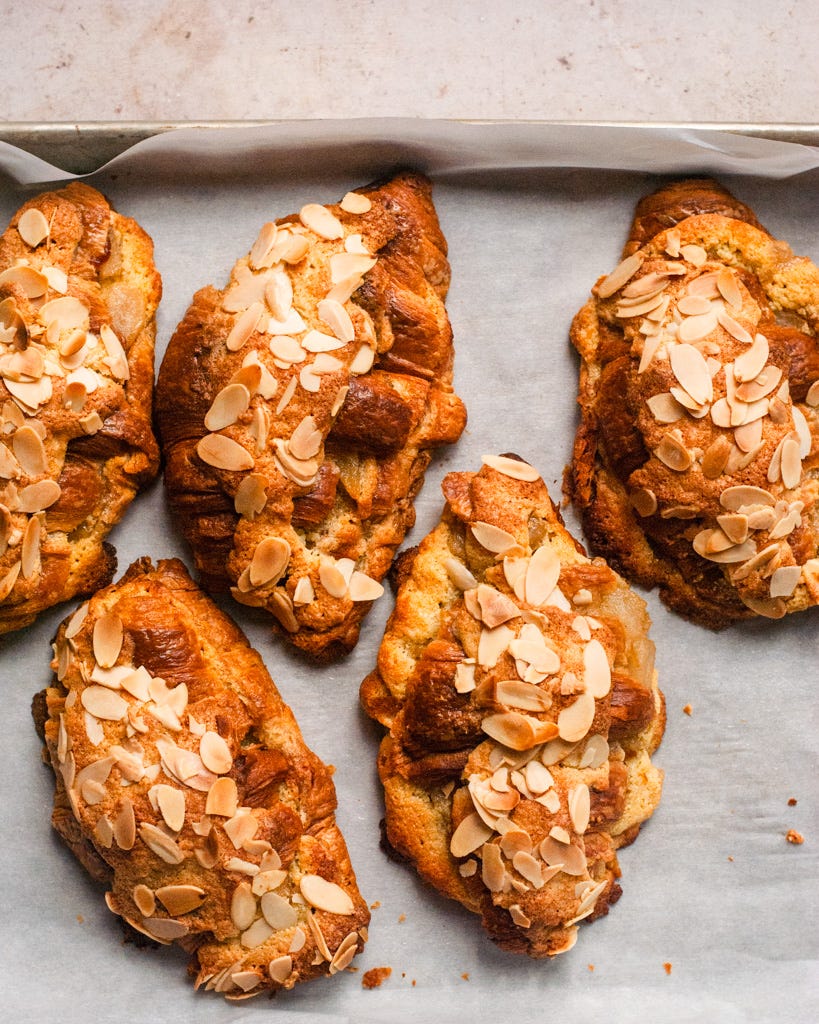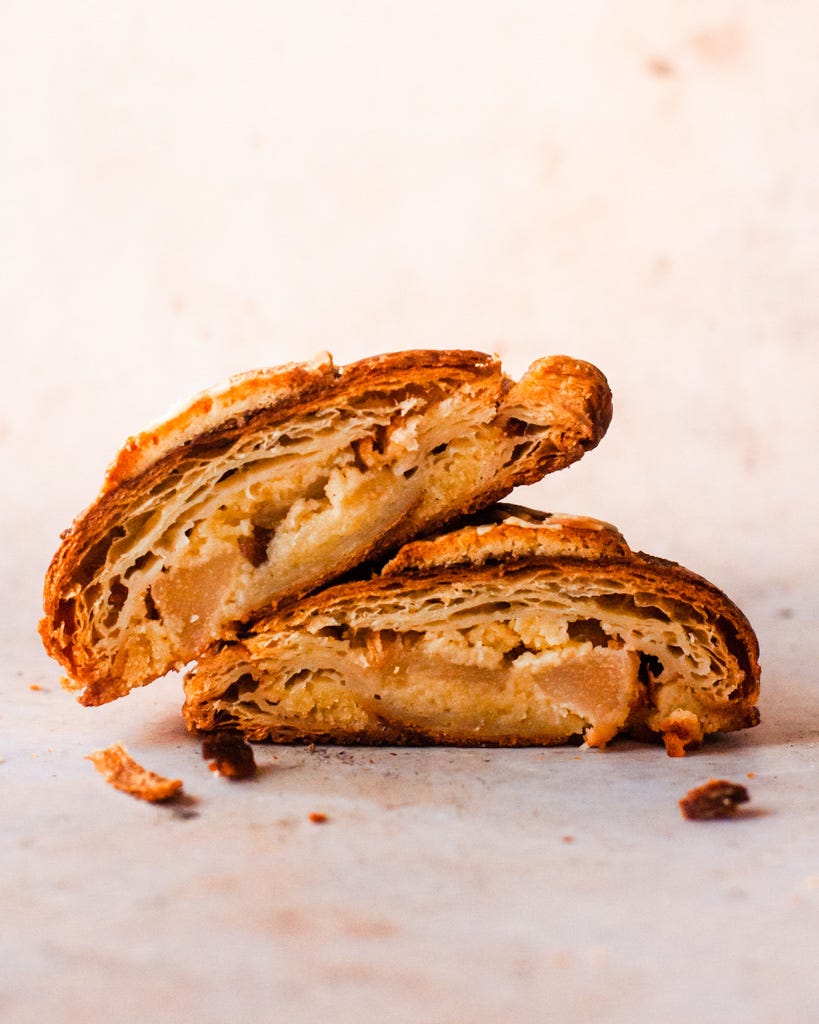Hello hello!
I have a soft spot for recipes that transform leftovers into something new and delicious — think French toast, bread pudding, trifles, panzanella, fried rice. Today I want to talk about one my all time favorites in the “leftovers” genre — the classic almond croissant. Props to the genius baker who first revived stale croissants with syrup, almond cream, and a lid of toasted nuts!
If you start with store-bought croissants, making twice-baked croissants at home is simple. It’s also the perfect bake for flexing some creativity and/or using up even more leftovers. Once you have the general template, you can go in SO many directions. So let’s dive into the anatomy of a twice-baked croissant.
It starts with stale croissants
First, you need to get yourself some croissants. If you have access to good-quality day-old croissants from a local artisan bakery, great! But honestly, plain old supermarket croissants work just fine. You can even use pain au chocolat (chocolate croissants) if you want something a little more decadent.
Twice-baked croissants work best with stale croissants — they’ll be primed to soak up more of the delicious syrup we’re going to spread on them. So leave them out, uncovered, for at least a few hours or overnight.
Simple Syrup
With twice-baked croissants, you have several opportunities to infuse flavor. With each of the elements, feel free to get creative to come up with some unique flavor combinations!
The first flavor layer is simple syrup. At its most basic, simple syrup is just sugar heated with an equal amount of water. For twice-baked croissants, I prefer to use a lighter syrup, more like 1 part sugar to 2 parts liquid. I like to flavor mine with a little alcohol (rum, whisky, or bourbon), but that’s totally optional. You could add vanilla or almond extract, or if you want to get fancy…
Infuse citrus zest, herbs, or spices to the syrup (add it to the syrup after the sugar has dissolved and let infuse until the syrup cools, then strain before using).
Replace part of the water with lemon juice for a lemon simple syrup.
Replace the granulated sugar with brown sugar.
Frangipane
A mixture of butter, sugar, egg, and almond flour, frangipane (or almond cream)1 is one of the secret sauces of pastry chefs. It’s also the delicious filling and topping for our twice-baked croissants, and another opportunity for added flavor. Frangipane is usually a 1:1:1:1 ratio of butter:sugar:egg:almond flour, with optional flavorings and sometimes a bit of regular flour or cornstarch to add structure. However, when used as a sandwiched filling, dialing back the egg makes the frangipane a little stiffer and less likely to seep out of the croissants.
You can customize your frangipane in a few ways:
Replace half the almond flour with another kind of ground nut or seed — think hazelnuts, walnuts, pecans, pistachios, sesame seeds. If you’re grinding your own nuts, toast them first.
Replace the granulated sugar with brown sugar or another sweetener like honey or maple syrup. With liquid sweetener, I usually use only 3/4 the amount (by weight) since they taste sweeter than regular sugar.
Melt or brown the butter and infuse it with herbs or tea/coffee. (Strain and chill the butter back to a spreadable consistency before making the frangipane.)
Experiment with additions: spices/citrus zests/extracts/alcohol are easy ways to start, but you can even try adding a little mashed banana or pumpkin puree or melted chocolate or cocoa powder. These additions may take some dialing in to figure out ideal proportions, but frangipane is pretty flexible and you can add a little extra flour if needed to give the cream some structure.
In addition to frangipane, I also like sneaking in some fruit preserves or compotes, or a swipe of jam into my twice-baked croissants (something tart and not-too-sweet is best, lest the croissants become cloying).
Topping
The final element to a twice-baked croissant is the topping. After spreading on a bit of frangipane for glue, sprinkle on flaked nuts / seeds / coarse sugar for visual interest and texture. Personally, I love traditional flaked almonds and think it’s crucial that twice-baked croissants stay in the oven long enough for those nuts to get nice and toasted.
Post-bake, twice-baked croissants often get showered with icing sugar right before serving. But you could definitely go a little crazy here too — citrus zest, freeze-dried fruit powder, drizzled melted chocolate, salted caramel sauce, whipped cream, etc.
Want more twice-baked croissant inspiration? Check out places like Lune, Supermoon Bakehouse, and Born and Bread!
Spiced syrup and a layer of buttery sauteed pears inject autumnal warmth into a classic almond croissants. Be generous with the syrup and fillings, and bake until the almonds on top are properly golden: I find these details are what takes a twice-baked croissant from ok to great.
Pear and Almond Twice-Baked Croissants
Makes 6-8 croissants
Ingredients:
For the spiced syrup:
60g light brown sugar
110g water
1/2 tsp whole cloves
1/2 tsp allspice berries
2” piece of cinnamon stick
Healthy grating of fresh nutmeg
1 Tbsp rum, brandy, or bourbon (or sub vanilla extract)
For the sauteed pears:
28g unsalted butter
25g sugar (granulated or brown)
450g ripe but firm pears (prepared weight), peeled, cored, and cut into 1/2” cubes (I like Bosc)
Pinch of kosher salt
1/2 tsp ground cinnamon
For the frangipane:
200g unsalted butter, at room temperature
200g granulated sugar
2g (1/2 tsp) kosher salt
1 tsp vanilla extract
1/4 tsp almond extract
100g eggs (about 2 large)
200g almond flour
15g all-purpose flour
For assembly:
6-8 day-old croissants, split horizontally
6-8 Tbsp apple butter (optional)
Flaked almonds
Icing sugar (optional, for garnish)
Method:
Make the spiced syrup: Combine the sugar, water, and spices in a small saucepan and bring to a simmer over medium heat, stirring until the sugar has dissolved. Turn off the heat and stir in the rum (if using). Pour the syrup along with all the spices into a heat-safe container and cool to room temperature. (Syrup can be refrigerated for up to 1 month. I like to keep the spices in to further infuse it.)
Make the sauteed pears: In a medium saucepan over medium heat, melt the butter. Once melted, stir in the sugar and stir until dissolved. Add the pears, salt, and cinnamon and stir to coat evenly with the butter. Cook, stirring frequently, until the pears are tender but still have some bite, 2-3 minutes. Use a slotted spoon to transfer the pears to a clean container, then continue cooking down the liquid until thick and syrupy. Scrape over the pears, stir to combine, and let cool to room temperature. (Pears can be made ahead and refrigerated for up to 3 days.)
Make the frangipane: In the bowl of a stand mixer fitted with the paddle attachment (or in a medium bowl with an electric hand mixer), beat together the butter, sugar, and salt until smooth and lightened in color, 3-4 minutes. Beat in the eggs one at a time, followed by the extracts (mixture may look curdled; this is normal). Fold in the flours until evenly combined and smooth. (Frangipane can be refrigerated for up to 5 days or frozen for up to 3 months; bring to spreadable room temperature before using).
Assemble and bake the croissants: Preheat the oven to 350F with a rack in the middle. Line a large baking sheet with parchment paper or a silicone baking mat.
Brush both cut sides of the croissants liberally with simple syrup, followed by a slick of apple butter, if using.
Reserve about a quarter of the frangipane for the tops of the croissants and transfer the rest to a piping bag fitted with a large round tip (or just cut a 1/2” opening).
Pipe an even layer of frangipane over the bottom halves of the croissants, then top with a layer of the sauteed pears (if the pears have released a lot of liquid, drain them before adding).
Place the tops back onto the croissants and press gently to secure. Spread the remaining frangipane over the tops of the croissants and sprinkle with the sliced almonds.
Bake until the almonds on top are deeply golden and fragrant and the inside frangipane is set, 25-35 minutes. The baking time can vary considerably depending on the size of your croissants, so use these cues: a skewer poked into the center should come out clean. If you pry a croissant open slightly, the frangipane inside should look matte and cooked, not shiny and raw. Finally, the internal temp should register above 195F.
Cool on a wire rack, then enjoy slightly warm or at room temperature. Dust with icing sugar right before serving, if desired. Twice-baked croissants are best the day they’re baked, but you can store leftovers for a day or two in an airtight container at room temperature. Reheat for a 5 minutes at 300F to refresh.
Technically, I think the butter/sugar/egg/almond flour mixture is almond cream. If you fold pastry cream into almond cream, it then becomes frangipane. But you’ll often see the two terms used interchangeably. Both are different from almond paste, which is a denser mixture of almond flour, icing sugar, and syrup or egg white.







I am especially keen to try a pastry recipe that doesn't require a particular facility in handling laminated dough, like chef Alex Raij's Croissants a la Plancha which similarly revives day-old croissants by splitting them and browning the webs and crevices with honey, butter and vanilla bean caviar. Plate with a favorite orange marmalade and dust with powdered sugar.
Your profile is similar to Bakeshop's crispy almond croissant with frangipane filling and orange blossom vanilla syrup.
I can't wait to plan a weekend baking project, thank you!